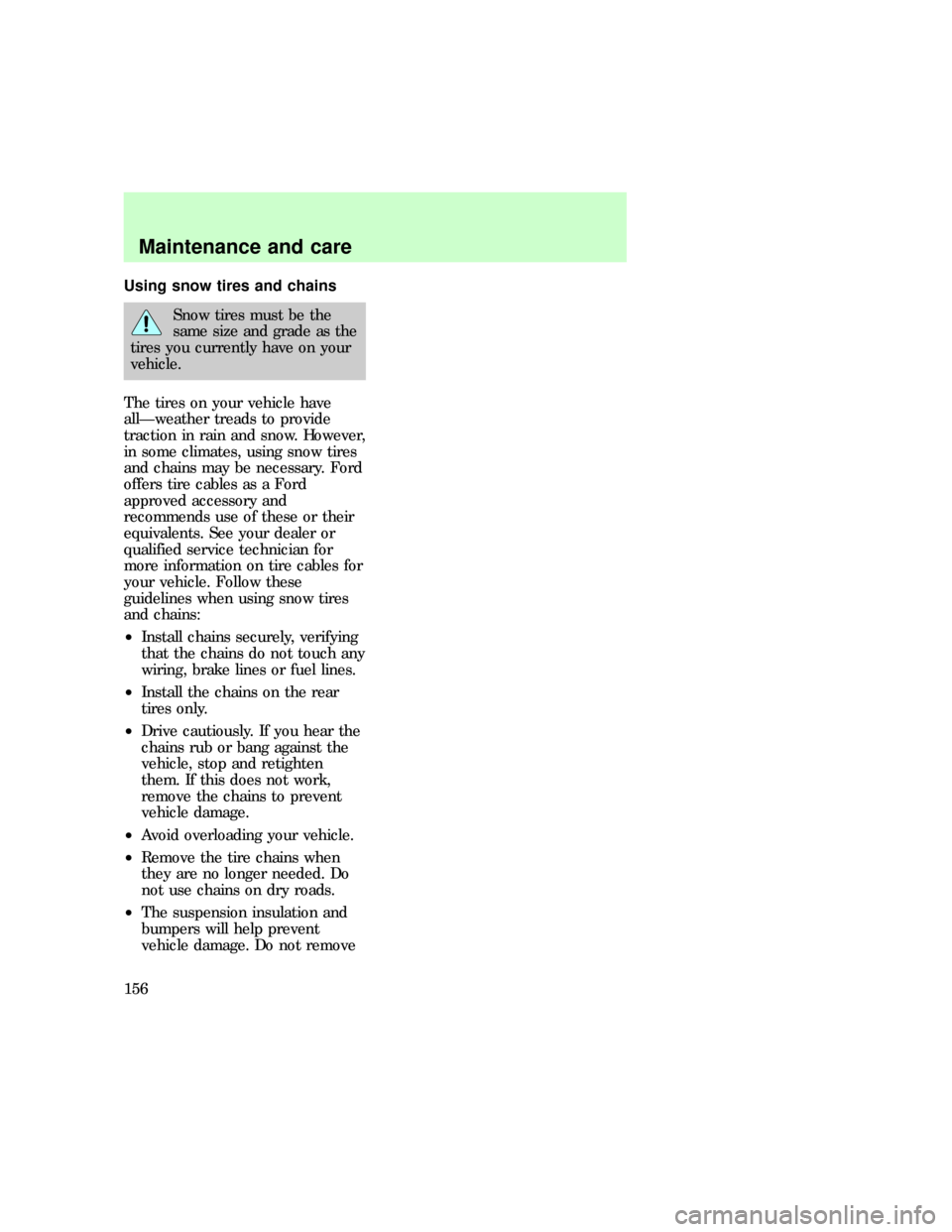Page 155 of 192
²Five tire rotation
Replacing the tires
Replace the tires when the wear
band is visible through the tire
treads.
When replacing full size
tires, never mix radial,
bias-belted, or bias-type tires.
Use only the tire sizes that are
listed on the tire pressure decal.
Make sure that all tires are the
same size, speed rating, and
load-carrying capacity. Use only
the tire combinations
recommended on the decal. If
you do not follow these
precautions, your vehicle may
not drive properly and safely.
When purchasing replacement tires
for your vehicle, consult your
dealer or qualified service
technician to ensure that the
correct tire types are used.
eco_types_tires
eco_snow_chains
Maintenance and care
155
Page 156 of 192

Using snow tires and chains
Snow tires must be the
same size and grade as the
tires you currently have on your
vehicle.
The tires on your vehicle have
allÐweather treads to provide
traction in rain and snow. However,
in some climates, using snow tires
and chains may be necessary. Ford
offers tire cables as a Ford
approved accessory and
recommends use of these or their
equivalents. See your dealer or
qualified service technician for
more information on tire cables for
your vehicle. Follow these
guidelines when using snow tires
and chains:
²Install chains securely, verifying
that the chains do not touch any
wiring, brake lines or fuel lines.
²Install the chains on the rear
tires only.
²Drive cautiously. If you hear the
chains rub or bang against the
vehicle, stop and retighten
them. If this does not work,
remove the chains to prevent
vehicle damage.
²Avoid overloading your vehicle.
²Remove the tire chains when
they are no longer needed. Do
not use chains on dry roads.
²The suspension insulation and
bumpers will help prevent
vehicle damage. Do not remove
Maintenance and care
156
Page 157 of 192
these components from the
vehicle when using snow tires
and chains.
WHAT YOU SHOULD KNOW
ABOUT AUTOMOTIVE FUEL
Important safety precautions
Do not overfill the fuel
tank. The pressure in an
overfilled tank may cause
leakage and lead to fuel spray
and fire.
If you do not use the
proper fuel cap, the
pressure in the fuel tank can
damage the fuel system or cause
it to work improperly in a
collision.
The fuel system may be
under pressure. If the fuel
cap is venting vapor or if you
hear a hissing sound, wait until it
stops before completely
removing the cap.
Automotive fuels can
cause serious injury or
death if misused or mishandled.
eco_fuel_info
com_important_precautions.06
Maintenance and care
157
Page 185 of 192

checking the pressure ............153
replacing ...........................116,155
rotating ....................................155
snow tires and chains ............156
spare tire .................................112
tire grades ...............................151
treadwear ................................151
Towing your vehicle .................123
Trailer towing ..............................94
safety chains .............................96
tips .............................................97
trailer brakes .............................96
trailer lamps ..............................96
Transmission
automatic operation .................83
fluid, checking and adding
(automatic) .............................141
Trip odometer .............................14Turn signal
indicator lights ..........................10
Vehicle Identification Number
(VIN) ..........................................181
Ventilating your vehicle .............79
Voltmeter (see Battery voltage
gauge) ..........................................13
Warning chimes ...........................11
headlamps on ............................11
key in ignition ...........................11
safety belt .................................11
Warning lights (see Lights) .........8
Washer fluid ..............................135
Windshield washer fluid and
wipers ........................................149
checking and replacing wiper
blades ......................................150
operation ...................................27
Index
185